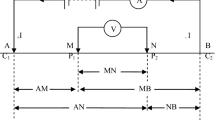Summary
A device that measures the resistance of wood to forceable penetration by a needle was appraised for use as a nondestructive means of detecting internal decay in utility poles. Because of the length and shape of the needle, detection of decay was limited to decay pockets within 6 cm of the wood surface and to pockets with a minimum diameter of 1 cm. Decay pockets of this location and size were detected in Douglas-fir, southern pine, and western redcedar. The device accurately detected decay in an advanced stage in 93% of the specimens; intermediate decay, in 44%; and sound wood, in 100%.
The depth of the sound shell that overlaid rot pockets could be accurately determined. There was a tendency to overestimate the depth of the sound wood by about 0.75 cm in comparatively dry woods and by about 0.25 cm in the same woods after wetting to moisture contents more like those in decayed poles in service.
The device will be useful to pole inspectors for locating seriously rotted poles because by determining the extent of sound shell, they can then decide when pole replacements are needed.
Zusammenfassung
Die vorliegende Untersuchung dient der Überprüfung eines Gerätes, das den Widerstand des Holzes gegen das Eindringen einer Nadel mißt. Damit soll auf zerstörungsfreiem Wege etwaige Fäulnis in stehenden Leitungsmasten festgestellt werden. Länge und Form der Prüfnadel begrenzen die Prüfungen auf Fehlerstellen, die bis höchstens 60 mm in die Tiefe reichen und nicht kleiner als 10 mm im Durchmesser sind. Faulstellen dieser Art wurden in Masten aus Douglas-fir, Southern pine und Western red cedar festgestellt. Die Vorrichtung zeigte sehr genau bei 93% der Proben fortgeschrittene Fäulnis an, bei 44% der Proben beginnende Fäulnis und bei 100% aller Proben gesundes Holz.
Die Dicke des noch vorhandenen gesunden Holzes über der Faulstelle konnte genau ermittelt werden. Es zeigte sich eine gewisse Tendenz zu Fehlmessungen um rd. 7,5 mm bei verhältnismäßig trockenem Holz und um 2,5 mm, nachdem dasselbe Holz etwas stärker angefeuchtet worden war, als dies gewöhnlich bei befallenen Masten der Fall ist.
Das Gerät wird vor allem für die Inspektion von stehenden Masten nützlich sein, die Befall aufweisen, wobei die Bestimmung des noch gesunden Holzanteils einen Anhaltspunkt dafür liefert, wann ein befallener Mast ausgewechselt werden muß.
Similar content being viewed by others
References
Anonymous: Device for Determining the Presence of Decay in Trees and Wooden Poles. Forestry Equip. Notes E. Vol. 33. 63 (1963) FAO.
Dana, H. J., and H. A. Stingle: The Torque Screw Pole Tester. Wash. State Coll. Bull. Vol. 8 (1947) No. 10, p. 1/35.
Eslyn, W. E.: Radiographical Determination of Decay in Living Trees by Means of the Thulium X-ray Unit. Forest Sci. Vol. 5 (1959) No. 1, p. 37/47.
Galligan, W. L.: A Status Report. Nondestructive Testing in Wood. For. Prod. J. Vol. 14 (1964) pl. 221/227.
Hearmon, R. F. S.: Nondestructive Tests to Evaluate the Physical and Mechanical Properties of Wood and Wood Products. Fifth World Forestry Congress Proc., Aug. 29-Sept. 10, 1960, Vol. 2 (1962) p. 1318/1323.
Hearn, A. H.: Maintenance Inspection of Wood Pole Lines. Wood Utility Pole Conf., Iowa State Univ., Ames, Iowa, Oct. 19–21, 1960, p. 63/75. (Mimeo.).
Kollmann, F. F. P.: Nondestructive Testing of Mechanical Properties of Wood and Wood Products. Fifth Conf. on Wood Tech., FAO, U. S. Forest Prod. Lab., Madison, Wis., Sept. 16–27, 1963 (Mimeo).
v. Kruedener, H. J.: Gerät zur annähernd zerstörungsfreien, selbstregistrierenden Untersuchung von Holzkörpern und lebenden Bäumen auf deren Gesundheitszustand. (A Device that Automatically Registers the Condition of Living Trees and Wood Products without Destruction to the Wood.). Mitt. Deutsch. Ges. Holzforsch. Vol. 48 (1961) p. 43/44.
Kubiak, M.: Uwagi o przydatnos'ci nowej metody do oznaczania zgnilizny drewna drzew stojacych. (Comment on the Usefulness of the New Method for Appraisal of Wood Rot). Sylwan Vol. 107 (1963) No. 4, p. 43–46.
Miller, B. D., F. L. Taylor, and R. A. Popeck: A sonic Method for Detecting Decay in Wood Poles. Amer. Wood-Preserv. Assoc. Proc. Vol. 61 (1965) p. 109/115.
Morris, C. O.: Ultrasonics for Wood Industries. Forest Prod. Res. Rep. No. E-2, Oreg. Forest Res. Center, Corwallis, Oreg. (1960) p. 1/40. (Mimeo.).
Zycha, H., and L. Dimitri: Erfahrungen mit einem Gerät zur Fäuleermittlung an stehenden Stämmen. (Experience with a Device for Determination of Decay in Growing Trees.) Forstw. Cbl. Vol. 81 (1962) No. 7/8, p. 222/230.
Author information
Authors and Affiliations
Additional information
This work was done cooperatively with the Navy Department, Naval Facilities Engineering Command.
The author is indebted to Dr. Wolman G.m.b.H., Sinzheim bei Baden-Baden, Germany, for loan of the needle-penetration device, and Messrs. Robert Graham and John Mothershead, Oregon Forest Products Laboratory, Corvallis, Oreg., and Floyd Hand, Bonneville Power Administration, for supplying the pole sections.
Rights and permissions
About this article
Cite this article
Eslyn, W.E. Utility pole decay — Part I: Appraisal of a device for nondestructive detection of decay. Wood Sci.Technol. 2, 128–137 (1968). https://doi.org/10.1007/BF00394961
Received:
Issue Date:
DOI: https://doi.org/10.1007/BF00394961




